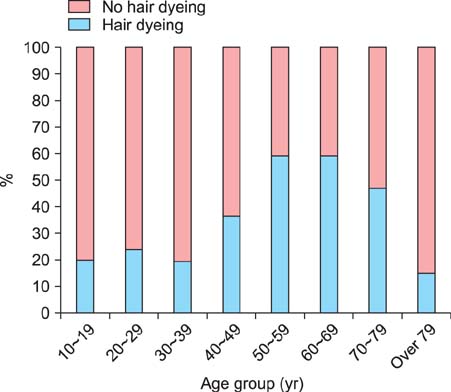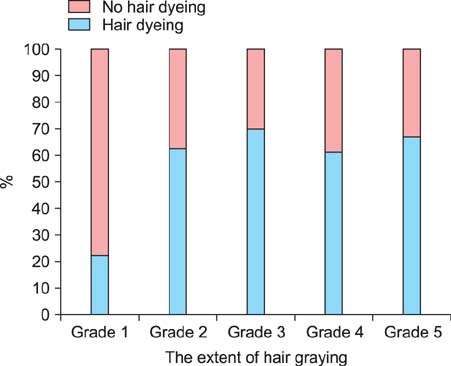Ann Dermatol.
2013 Nov;25(4):401-404. 10.5021/ad.2013.25.4.401.
The Pattern of Hair Dyeing in Koreans with Gray Hair
- Affiliations
-
- 1Department of Dermatology, Medical Research Center, Seoul National University College of Medicine, Seoul, Korea. oskwon@snu.ac.kr
- 2Institute of Dermatological Science, Medical Research Center, Seoul National University College of Medicine, Seoul, Korea.
- 3Department of Dermatology, SMG-SNU Boramae Medical Center, Seoul, Korea.
- KMID: 2265044
- DOI: http://doi.org/10.5021/ad.2013.25.4.401
Abstract
- BACKGROUND
Hair graying is considered as a part of normal ageing process. Nonetheless, this process raises a significant cosmetic concern, especially among ethnic Korean elderly whose baseline hair color is black. For this reason, Korean elderly dye their hair with frequency despite the risk of dermatologic problems such as allergic contact dermatitis.
OBJECTIVE
In this study, the authors investigate the prevalence and pattern of hair dyeing and its relation with scalp diseases in Korea.
METHODS
Six hundred twenty subjects (330 men and 290 women) with graying hair were given a questionnaire survery and underwent a physical examination.
RESULTS
Of the 620 total, 272 subjects (43.9%) dyed their hair. Hair dyeing was significantly more frequent among women than among men (p<0.001). Subjects from 50 to 69 years of age showed higher prevalence of hair dyeing when compared to either younger or older groups. Subjective self-assessment of the extent of hair graying was associated with increased prevalence of hair dyeing, that is, individuals who feel graying has advanced by more than 20% of the overall hair were much more likely to dye their hair (p<0.001). Hair dyeing did not correlate with either alopecia or scalp disease.
CONCLUSION
Our survey has found that the prevalence of hair dyeing is higher among Korean women than men. People in their fifties and sixties and people with more than 20% extent of grayness were more likely to dye their hair than otherwise. Hair dyeing was not associated with any increase in the prevalence of scalp diseases.
Keyword
MeSH Terms
Figure
Cited by 1 articles
-
Efficacy and Safety of Pueraria lobata Extract in Gray Hair Prevention: A Randomized, Double-Blind, Placebo-Controlled Study
Seong Jin Jo, Hyoseung Shin, Seung Hwan Paik, Sun Jae Na, Yingji Jin, Won Seok Park, Su Na Kim, Oh Sang Kwon
Ann Dermatol. 2013;25(2):218-222. doi: 10.5021/ad.2013.25.2.218.
Reference
-
1. Trüeb RM. Aging of hair. J Cosmet Dermatol. 2005; 4:60–72.
Article2. Lapeere H, Boone B, Schepper SD, Verhaeghe E, Ongenae K, Geel NV, et al. Hypomelanoses and hypermelanoses. In : Wolff K, Goldsmith LA, Katz SI, Gilchrest BA, Paller AS, Leffell DJ, editors. Fitzpatrick's dermatology in general medicine. 7th ed. New York: McGraw-Hill;2008. p. 622–640.3. Keogh EV, Walsh RJ. Rate of greying of human hair. Nature. 1965; 207:877–878.
Article4. Cline DJ. Changes in hair color. Dermatol Clin. 1988; 6:295–303.
Article5. Gould L, Reddy CV, Oh KC, Kim SG, Becker W. Premature hair graying: a probable coronary risk factor. Angiology. 1978; 29:800–803.
Article6. Schnohr P, Lange P, Nyboe J, Appleyard M, Jensen G. Gray hair, baldness, and wrinkles in relation to myocardial infarction: the Copenhagen City Heart Study. Am Heart J. 1995; 130:1003–1010.
Article7. Eisenstein I, Edelstein J. Gray hair in black males a possible risk factor in coronary artery disease. Angiology. 1982; 33:652–654.
Article8. Gould L. Premature gray hair and coronary artery disease. Am Heart J. 1996; 132:1317.
Article9. Rosen CJ, Holick MF, Millard PS. Premature graying of hair is a risk marker for osteopenia. J Clin Endocrinol Metab. 1994; 79:854–857.
Article10. Bulpitt CJ, Markowe HL, Shipley MJ. Why do some people look older than they should? Postgrad Med J. 2001; 77:578–581.
Article11. Jo SJ, Paik SH, Choi JW, Lee JH, Cho S, Kim KH, et al. Hair graying pattern depends on gender, onset age and smoking habits. Acta Derm Venereol. 2012; 92:160–161.
Article12. Lee K, Lim HS. Survey on the symptoms related to hair dyeing among university freshmen. Korean J Prev Med. 2003; 36:223–229.13. Søsted H, Hesse U, Menné T, Andersen KE, Johansen JD. Contact dermatitis to hair dyes in a Danish adult population: an interview-based study. Br J Dermatol. 2005; 153:132–135.
Article14. Søsted H, Agner T, Andersen KE, Menné T. 55 cases of allergic reactions to hair dye: a descriptive, consumer complaint-based study. Contact Dermatitis. 2002; 47:299–303.
Article15. Thyssen JP, White JM. European Society of Contact Dermatitis. Epidemiological data on consumer allergy to p-phenylenediamine. Contact Dermatitis. 2008; 59:327–343.16. Scheman A, Cha C, Bhinder M. Alternative hair-dye products for persons allergic to para-phenylenediamine. Dermatitis. 2011; 22:189–192.
Article
- Full Text Links
- Actions
-
Cited
- CITED
-
- Close
- Share
- Similar articles
-
- A Survey of the Awareness, Knowledge and Behavior of Hair Dye Use in a Korean Population with Gray Hair
- Survey on the Symptoms Related to Hair Dyeing among University Freshmen
- DNA Damage in Lymphocytes after Hair Dyeing and Related Factors among Women Volunteers
- Statistical and Clinical Study of Gray Hair
- Hair characteristics and androgenetic alopecia in Koreans



